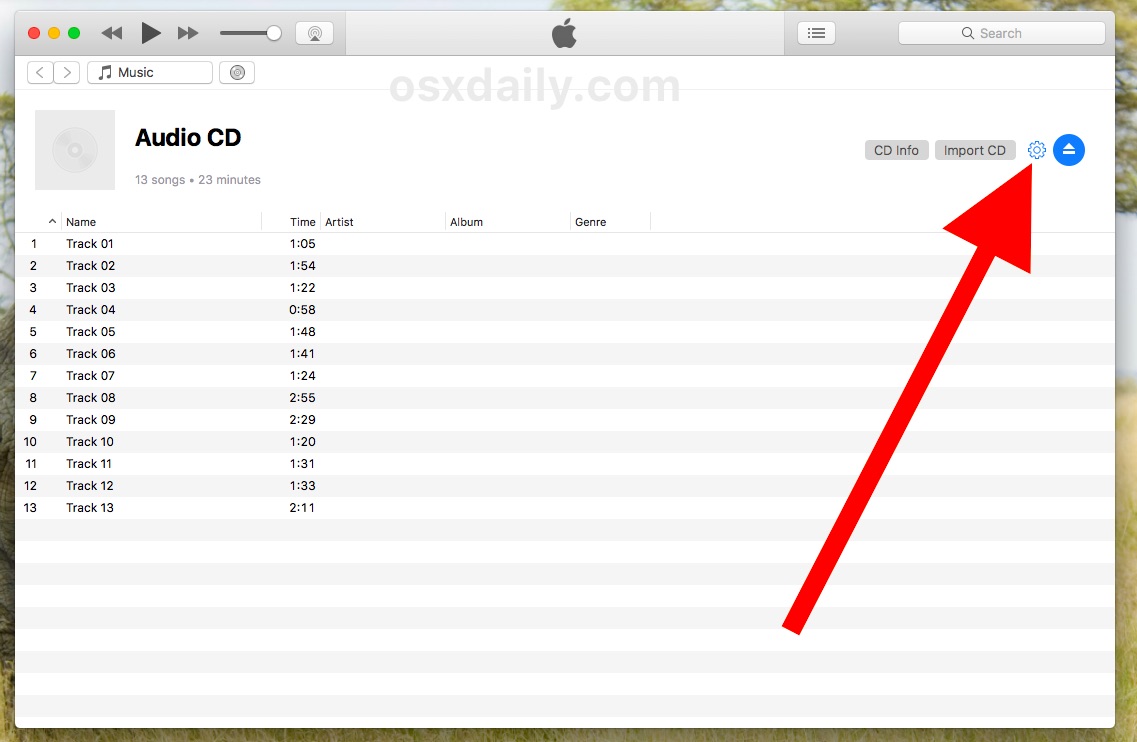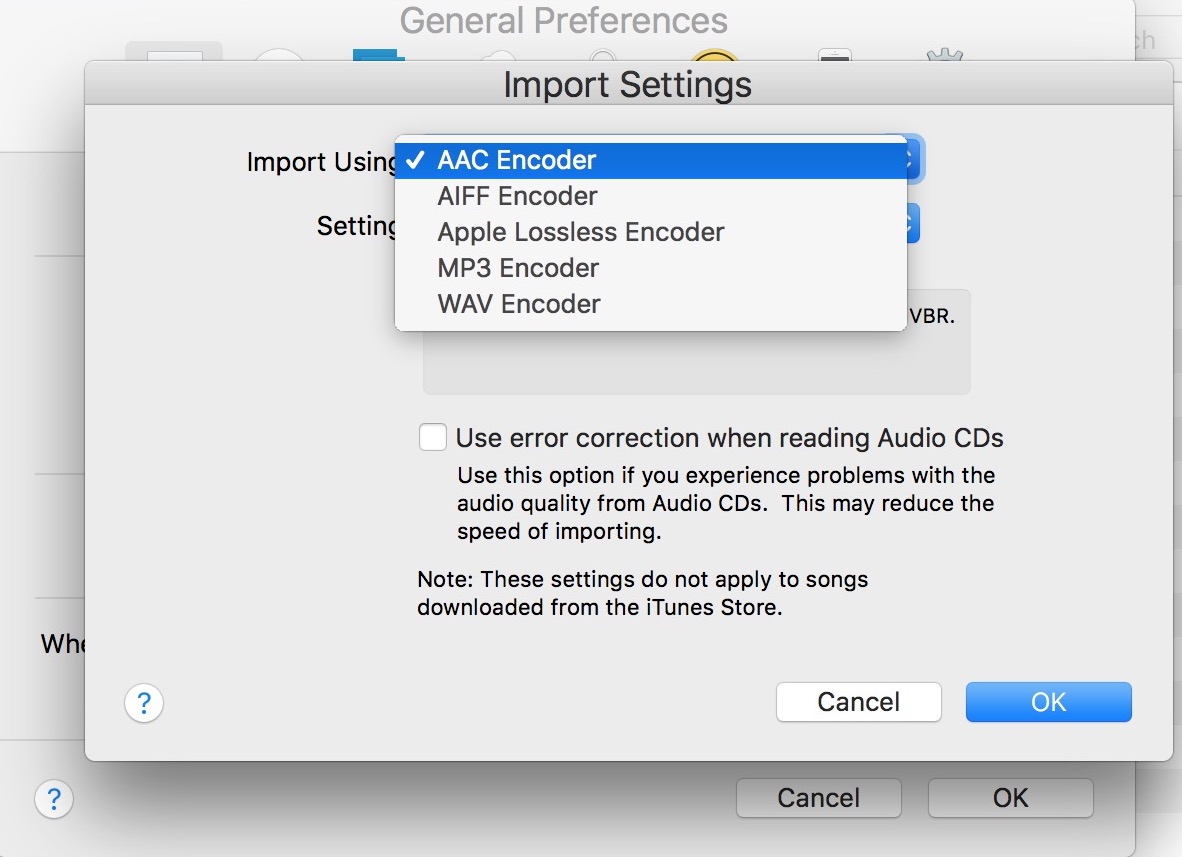How to Change Audio Import Settings in iTunes on Mac & Windows
![]()
If you’re ripping CDs to import a music collection into iTunes on a Mac or Windows PC, you may be interested in knowing that you can change the media encoding for imported music. By default, iTunes will import and rip CDs using the MP3 Encoder at 160kbps, but if you want to change the encoding settings you will find options to import the CD and encode music as AAC, AIFF, Apple Lossless (m4a), MP3, and WAV.
There are two ways to access the iTunes encoder settings for importing music from CDs, either directly from the import screen, or from the iTunes Preferences. Accessing is the same in iTunes for Mac OS and for Windows. However you access the import settings, the settings will be the same and will become the default for future importing of CDs into iTunes.
First let’s cover the simplest way to adjust import encoder settings in iTunes, which is part of the general importing screen seen when inserting a CD into a computer with iTunes.
How to Change iTunes CD Importing Encoder Settings on Import
- Open iTunes and insert a CD to rip as usual
- At the Import screen, click the little gear icon in the upper right corner, it’s next to the eject button
- Adjust the audio import encoding settings as desired, selecting one of the following options:
- AAC Encoder
- AIFF Encoder
- Apple Lossless Encoder
- MP3 Encoder
- WAV Encoder
- Next, but optional, you can adjust quality settings for imported music in the “Setting” section. Higher quality and higher bitrate audio files will sound better, but take up more disk space
- Proceed with ripping the CD into iTunes as usual


You can also change import encoder settings through iTunes Preferences. This can be done even if iTunes does not actively have a CD to import or rip audio from.
How to Change iTunes CD Encoding via Preferences
- Open iTunes and then go to “Preferences” from the iTunes menu
- Under “General” settings click on “Import Settings”
- Adjust the iTunes import settings as desired:
- AAC Encoder
- AIFF Encoder
- Apple Lossless Encoder
- MP3 Encoder
- WAV Encoder
- Next you can also choose to adjust the quality settings, though each encoder offers different quality options. Generally speaking, for the highest quality encoding, choose a higher quality or higher bitrate setting (256kbps is notably higher quality than 160kbps for example)
- When satisfied with your encoding settings, close out of iTunes Preferences and import music from audio CDs into iTunes as usual

It doesn’t really matter how you change the audio encoder and resulting file format, either approach will work.
Just remember that higher quality settings take up more disk space, which can be relevant for limited storage devices.
On the other hand, higher quality audio settings also sound much better, which is important for listening to music and audio on higher quality stereo systems – and yes for most people with reasonable hearing and a set of good speakers, good headphones, or a good stereo, you can hear the difference in sound quality between a 128kbps file and a 192kbps file. You can always test out the difference yourself by ripping the same song twice, one in low quality and one in higher quality settings, and as long as you have decent speaker or headphones, you should be able to hear a difference. Be aware if you’re testing the audio file formats with importing the same song, that you will create copies of the same song in the process, so you may want to use the Duplicate Song finder feature in iTunes to track down any duplicates after the fact and clean up your music library.
You can also use the aforementioned audio encoder settings in iTunes to re-encode audio files already in iTunes into another file format, for example you can use iTunes to convert m4a files to mp3 files and vice versa.
Audio encoding and file format is largely a matter of personal preference, but it can also vary per user and what they plan on listening to the music on, through, or with. For example, an mp3 file is nearly universally compatible and could even play on some much older mp3 players, whereas an Apple Lossless file is newer and likely wouldn’t play on older hardware dedicated MP3 players.
Do you love iTunes? Of course you do! Check out more iTunes tips here, and feel free to share your thoughts and opinions on audio encoding with iTunes in the comments below!


Ian T is absolutely correct. If you change an MP3 to a different format you are not making the sound quality any better (since so much of the file has been discarded to save space). You only will have a larger version of the crappy file. (Same is true for saving image jpegs as tiffs etc.)
I always heard that Apple Lossless was the way to go.
Some players do not support it, for example car audio systems, so it depends on the use.
Be advised, importing CD audio to anything but 16 bit 44.1k wav file results in a lower quality audio file that cannot be converted back. Once the conversion and loss takes place the process cannot be reverted. If you are considering converting your CD collection, I urge you to convert to 16 bit 44.1k wav files to preserve the quality.
If you must listen to lower quality formats, you can make copies and do so.
Helpful tips as usual; thanks.
I think it might be useful to remark that whilst re-encoding Apple Lossless audio files to MP3 saves space and works well, the opposite is not the case. It is impossible to improve the quality of an MP3 recording by re-encoding to Apple Lossless, for example. It will double or treble the storage space, but do nothing for the quality of the sound heard.